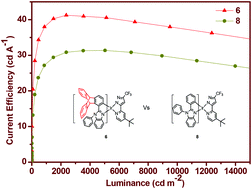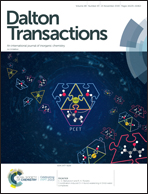Novel phosphorescent triptycene-based Ir(iii) complexes for organic light-emitting diodes†
Abstract
A series of charge-neutral cyclometalated iridium(III) complexes (1–3 and 5–7) containing triptycene-substituted ligands (tbt and tpbi) and two parent complexes (4 and 8) were synthesized and characterized. The crystal structures indicated that π–π stacking interactions existed in ligand tbtH, but not in complex 6. However, a large intramolecular repulsion was found in complex 6. These triptycene-based complexes exhibited good thermal stability, which was higher compared with that of the parent complexes. These complexes showed green to yellow emission with peaks that ranged from 503 to 563 nm. The introduction of the rigid non-conjugate triptycene skeleton caused a slight emission red shift (<25 nm), but a significant increase in the PLQYs (>47%) was observed. The electroluminescent devices employing 2 and 6 as phosphors displayed impressive performance improvements and low efficiency roll-off because of the higher PLQYs and HOMO levels of these triptycene-based complexes. The maximum current and external quantum efficiencies of the devices based on complexes 2 and 6 were 41.7 cd A−1, 11.9% and 41.2 cd A−1, 12.6%, respectively, which were about 31% higher than that of the devices based on the parent complexes 4 and 8. This work provides a novel approach to develop highly efficient phosphors with a triptycene skeleton.



 Please wait while we load your content...
Please wait while we load your content...